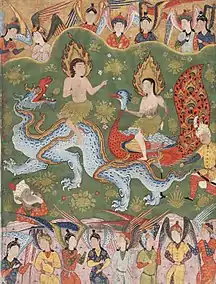Falnama
Falnama is a book of omens used by fortune tellers in Iran and Turkey during the 16th and 17th centuries. Individuals seeking insight into the future would engage in a series of purification rituals, turn to a random page in the Falnama, and interpret the text and drawings thereon for good or ill.[2] Falnama manuscripts were primarily created during the 16th and 17th centuries as the Islamic calendar was approaching the year 1000.[3]

_of_Ja'far_al-Sadiq_MET_DP148341.jpg.webp)
The Dispersed Falnama was an illustrated Falnama that was commissioned by Shah Tahmasp in mid-1550s-early-1560s.[4] Many of the paintings involve Ali, who was considered the first Shi'i Imam and central to the Safavid Empire's state ideology. In the "Coffin of Imam 'Ali" painting, Ali is depicted with a flaming halo which was a technique of the preexisting Zoroastrian art in Iran.
External links
References
- ""Coffin of Imam 'Ali"". www.metmuseum.org. Retrieved 2018-12-14.
- Falnama's Book of Omens, accessed 11/29/09
- BBC: Behind the Books of Omens
- "Falnama: The Book of Omens". www.caareviews.org. Retrieved 2018-12-14.